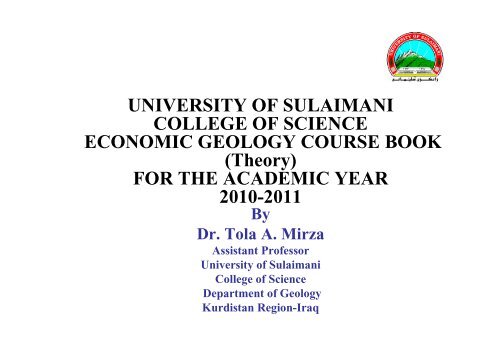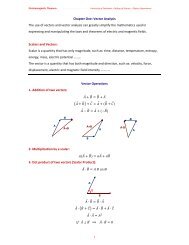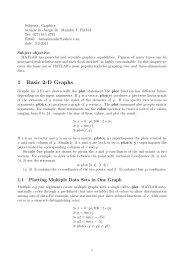Eco. Lec. Syllabus.pdf - University of Sulaimani
Eco. Lec. Syllabus.pdf - University of Sulaimani
Eco. Lec. Syllabus.pdf - University of Sulaimani
Create successful ePaper yourself
Turn your PDF publications into a flip-book with our unique Google optimized e-Paper software.
UNIVERSITY OF SULAIMANI<br />
COLLEGE OF SCIENCE<br />
ECONOMIC GEOLOGY COURSE BOOK<br />
(Theory)<br />
FOR THE ACADEMIC YEAR<br />
2010-2011<br />
By<br />
Dr. Tola A. Mirza<br />
Assistant Pr<strong>of</strong>essor<br />
<strong>University</strong> <strong>of</strong> <strong>Sulaimani</strong><br />
College <strong>of</strong> Science<br />
Department <strong>of</strong> Geology<br />
Kurdistan Region-Iraq
�College: Science<br />
�Department: Geology<br />
�Course: <strong>Eco</strong>nomic Geology / 4 th year students<br />
�Course coordinator: Dr. Tola A. Mirza<br />
�Email: tola.merza@univsul.net<br />
�Course link in the <strong>University</strong>: tola.merza@univsul.net<br />
�List <strong>of</strong> lecturers <strong>of</strong> this course: Dr. Tola A. Mirza
Course overview<br />
ï This course presents to the undergraduate fourth year Geology<br />
Department College <strong>of</strong> Science <strong>University</strong> <strong>of</strong> <strong>Sulaimani</strong>. The course<br />
work will be conducted over a period <strong>of</strong> one semesters <strong>of</strong> 15 ñ<br />
weeks including also laboratory and field classes.. The course is an<br />
attempt to provide the basic principles and some definition in ore<br />
geology. Also the course is an attempt to provide important points in<br />
<strong>Eco</strong>nomic geology such as the resource and reserves types,<br />
Geothermometry, Geobarometry, zoning and dating <strong>of</strong> ore deposits<br />
deposition, Classification <strong>of</strong> ore deposits, and giving detail about<br />
some magamtic ore deposits<br />
ï All the above and other important points such as localization <strong>of</strong> ore<br />
deposits and mineral associated with them in Kurdistan Region and<br />
other localities, Minerogenic map <strong>of</strong> metallic and non metallic<br />
mineral deposits in Iraq, chemical and geologic characteristic.
ï Main objectives <strong>of</strong> the course:<br />
ï The main objectives <strong>of</strong> the course are to provide a better<br />
understanding <strong>of</strong> the economic geology, become familiar with using<br />
<strong>of</strong> appropriate economic terminology . Processes as well as the<br />
nature and origin <strong>of</strong> mineral occurrences especially the metallic ore<br />
deposits in in general and especially those found in Kurdistan Region<br />
and how they fit into the earth system.<br />
ï The other objective is to provide opportunity in exploration <strong>of</strong> ore<br />
deposits and methods <strong>of</strong> finding them. All the above background<br />
knowledge for classification <strong>of</strong> ore deposits and Geothermometry,<br />
Geobarometry and isotopic studies.
Course references<br />
Text books available in the college library<br />
� Guilbert, J. M. and Park, C. F., 1986, The geology <strong>of</strong> ore<br />
deposits, W.H. Freeman and Company/ New York, 985p.<br />
� Jassim, S.Z. and G<strong>of</strong>f, C. Geology <strong>of</strong> Iraq, 2006, Published by<br />
Dolin,Prague Moravian Museum, Brno, 341p.<br />
� Jensen, M. L and Batman, A. M., 1979, <strong>Eco</strong>nomic mineral<br />
deposits 3rd edition, New York, 593p.<br />
� Mirza, T.A. Petrogenesis <strong>of</strong> the Mawat ophiolite complex and<br />
the associated chromitite, Kurdistan region, NE Iraq,<br />
Unpublished phD Thesis, <strong>University</strong> <strong>of</strong> sulaimani, 221p.<br />
� Tarling, D.H., 1981, <strong>Eco</strong>nomic geology and geotectonics,<br />
Blackwell Scientefic Publications, Oxford London Edinburgh,<br />
Bosten Mebourne, 312p.
Useful references:<br />
� Al-bassam, K. and Akif, A. 1977 The ore mineralogy <strong>of</strong> the Marabasta Lead-Zinc<br />
deposit Northeastern Iraq, Jour. Of Geological Society <strong>of</strong> Iraq, Vol. X, pp. 12-32.<br />
� Awadh, S.M. 2006 Mineralogy, geochemistry and origin <strong>of</strong> the Zinc-Lead-Barite<br />
deposits from selected areas from north OF Zakho, Northern Iraq, Unpublished<br />
PhD. Thesis, UNIVERSITY OF BAGHDAD,182 p.<br />
� Duke, M.J, Mineralogy <strong>of</strong> Canadian Mineral deposit types (Mafic- Ultramafic<br />
hosted chromitePages 615-620;<br />
� Evans, A.M., 1993, Ore Geology and Industrial Minerals An Introduction, Third<br />
Edition, Blackwell Publishing, PP.84-95<br />
� Jensen, M. L and Batman, A. M., 1979, <strong>Eco</strong>nomic mineral deposits 3rd edition,<br />
New York, 593p.<br />
� Musa, I, O, 2007, Petrography, Geochemistry and Genesis <strong>of</strong> Copper-Iron<br />
Mineralization and Associated Rocks in Waraz Area, Sulaimanya, NE Iraq,<br />
Unpublished MsC. Thesis, <strong>University</strong> <strong>of</strong> Baghdad,133 p.<br />
� Robb, L., Introduction to ore-forming process, (2005) Blackwell Publishing, 373p.<br />
� Mineral resource classification From Wikipedia, the free encyclopedia<br />
� Mineral Information Institute -- http://www.mii.org/<br />
� www.nd.edu/~emsi/Dahlheimer.REU03.ppt
<strong>Lec</strong>. No.<br />
-<br />
1 & 2<br />
3 & 4<br />
5<br />
6<br />
7 &8<br />
9 & 10<br />
11<br />
12<br />
<strong>Syllabus</strong><br />
<strong>Syllabus</strong>, References, Objectives<br />
Introduction to <strong>Eco</strong>nomic Geology<br />
Natural Resources and Reserves<br />
Geothermometry, Geobarometry, zoning and dating <strong>of</strong> ore deposits<br />
Classification <strong>of</strong> Ore Deposits<br />
Minerogenic zonation in Iraq<br />
Magmatic Base metal Deposits<br />
Platinum group Elements (PGEs)<br />
Subjects<br />
Hydrothermal mineral deposits and Metamorphic ore deposits
ï Assessment methods<br />
ï <strong>Lec</strong>tures, class discussion, homework, reading, final<br />
test<br />
ï Language <strong>of</strong> Instruction<br />
ï English<br />
�Course marks<br />
� First exam semester 1 (4 marks)<br />
� Second exam semester 1 (4 Marks)<br />
� The Pop quizzes (2 Marks)<br />
� Final lab exam 15%
Exams<br />
A- Times <strong>of</strong> exams<br />
The following patterns <strong>of</strong> examinations are depended for the<br />
<strong>Eco</strong>nomic geology course:<br />
Pop quizzes <strong>of</strong> the first semester (2 marks).<br />
The Pop quizzes are sudden short quizzes that can be taken during any<br />
theoretical or practical lecture (without any previous declaration).<br />
First Semester exams (4 marks).<br />
1- The first exam are usually taken by the end <strong>of</strong> the lecture No. 5.<br />
They include: 4 mark exam in theoretical lectures.<br />
2- The second exam are usually taken by the end <strong>of</strong> the lecture No. 10.<br />
They include: 4 mark exam in theoretical lectures.<br />
3- A 15 mark exam in the practical lectures.<br />
The final exams (25 marks).<br />
The final exams are usually taken by the end <strong>of</strong> the second semester.<br />
They include: 25 mark exam in theoretical lectures (<strong>Eco</strong>nomic<br />
Geology).
B- Examís duration<br />
No specific duration is determined for the Pop quizzes, it will be<br />
determined at their times depending on the number and type <strong>of</strong> the<br />
questions but usually, the duration <strong>of</strong> the pop quiz is not more than<br />
5 minutes.<br />
The duration <strong>of</strong> the first and second exams is 90 minute.<br />
The duration <strong>of</strong> the final exams is 90 minute for <strong>Eco</strong>nomic geology<br />
and 90 minute for industrial rocks and minerals (Total time 3<br />
hours).<br />
Answering technique by the student:<br />
Our advices to the students are:<br />
To read and think about the questions deeply before answering.<br />
If the student doesnít know the correct answer <strong>of</strong> a particular<br />
question, in this case there is no benefit from wasting the time and<br />
he (she) should skip it and go to the next, and at last when there is a<br />
space <strong>of</strong> time he (she) could go back and try to answer the skipped<br />
question
Type and samples <strong>of</strong> the exams<br />
ï Multiple choice questions<br />
1st Exam <strong>of</strong> <strong>Eco</strong>nomic geology<br />
Time: 1 hr. 23/12/2009<br />
Q1 / Select the suitable word for the following statements:<br />
Words:<br />
a- Mineral character, b- Qulqula Formation c- Halite ñgypsum, d- Injana Formation, e- undesirable substance,<br />
f- Low quartz to high Quartz, g- Walash Series, h- Siderophile, i- Chalcopyrite (cubic system invert to<br />
chalcopyrite (tetragonal system), j- Silicophile, k- Proven, L- By product, m- Thiophile, n- Measured, O- Smelting<br />
p-Reasonably assured, Q- Extractive metallurgy, r-Indicated, S- magmatic injection, T- Mineralogical form,<br />
u- Refining, V- Ore deposit character, w- Fatha Formation, X- Filter pressing, Y- Glauberite salttern<br />
Statements<br />
1- The ore mineral are considered to be naturally occurring compound valued for their metal content so further<br />
processing after mining should be adapt generally including -----------------, --------------, ----------<br />
2- The extraction <strong>of</strong> Ni from sulfide ore mineral are more easy than silicate ore mineral (it means the cut-<strong>of</strong>f grade for the<br />
former is 0.5 % and for the later is 1.5 % this explanation can be considered for one factor that controlling cut-<strong>of</strong>f like<br />
---------------------<br />
3- The ---------------reserve in B.S is equivalent to -----------------in international agency <strong>of</strong> uranium nucleation<br />
4- An example <strong>of</strong> polymorphism in metallic ore mineral is -----------------<br />
5- Partly crystallized magma in which subjected to differential external stress is called --------------- and the squeezed<br />
liquid into surrounding rock known as ---------------------<br />
6- The element partitioned in magma liquid into sulfide group called -------------- and those elements partitioned into<br />
oxide group is called --------------<br />
7- According to the minerogenic map <strong>of</strong> Iraq the economic mineral like native sulfur is related to ----------- Formation<br />
while the Cr-Ni deposits are related to ----------------<br />
8- According to the minerogenic map <strong>of</strong> Iraq an example <strong>of</strong> continental evaporite deposits is -------------- and an<br />
example on marine evaporite is ----------------
Answers<br />
1- O- Smelting, Q- Extractive metallurgy, u- Refining<br />
2- T- Mineralogical form<br />
3- k- Proven, p-Reasonably assured<br />
4- i- Chalcopyrite (cubic system to chalcopyrite (tetragonal system)<br />
5- X- Filter pressing, S- magmatic injection,<br />
6- m- Thiophile, h- Siderophile<br />
7- w- Fatha Formation, g- Walash Series,<br />
8- Y- Glauberite salttern, c- Halite ñgypsum
Compositional questions. Examples:<br />
Describe the Iron mineralization in the Zagrose Suture Zone.<br />
Three types <strong>of</strong> Iron mineralization are found in the Zagrose suture<br />
are:<br />
1- Contact metasomatic or skarn deposits.<br />
2- Magmatic segregation deposits.<br />
3- Hydrothermal veins and lenses <strong>of</strong> siderite.<br />
The major iron occurrence <strong>of</strong> contact metasomatic character are<br />
concentrated near Penjween the largest one is Asnawa deposit,<br />
located about 3.5 km S,SW <strong>of</strong> penjween town .<br />
Skarn type magnetite mineralization was also described from<br />
Marapasta area in the Qandil range <strong>of</strong> Zagrose suture Zone, NE <strong>of</strong><br />
Ranya.<br />
Magnetite occurs in small lenses in siliceous limestone and schist in<br />
the lower unit <strong>of</strong> penjween group accompanied by minor pyrrhotite,<br />
pyrite, chalcopyrite and arsenopyrite.
Compare between podiform and stratiform chromite deposits<br />
due to:<br />
1- TiO2 content in both type<br />
2- The rock associated within both type<br />
3- The field appearance<br />
4- Structure classification<br />
Answer<br />
Podiform<br />
1- TiO 2 < 0.3 %<br />
2- Ultramafic rocks (dunite,<br />
peridotites, pyroxenite)<br />
3- Lensoidal or podiform<br />
4- Three types they are<br />
Concordant, discordant,<br />
subcordant<br />
Stratiform<br />
1- TiO 2 > 0.3 %<br />
2- Ultramafic and mafic rocks<br />
mostly gabbroic rocks<br />
3- layered or stratiform<br />
4- structurally are layered
What are the exploration guidelines for PGE?<br />
Answers<br />
1- Identify layered mafic ñ ultramafic intrusions and differentiated<br />
sills (possibly cratonic).<br />
2- Sample any sulphide bearing materials especially if carrying visible<br />
pyrrohotite chalcopyrite mineralization.<br />
3- Look for any very thin (1m) but laterally persistent disseminated<br />
sulphide bearing horizon within complexly interlayer peridotites,<br />
pyroxenite, troctolite, anorthosite, and gabbro sequenences.<br />
4- Look for sulphide bearing material near contact zone <strong>of</strong> mafic ñ<br />
ultramafic complexes composed <strong>of</strong> several intrusive phases.<br />
5- Look for unusual textures and mineralogy namely looks for<br />
pegmatitic texture and development <strong>of</strong> hydrous minerals within<br />
layers or massive unit that are normally <strong>of</strong> even grain size and<br />
anhydrous.<br />
6- Investigate within the drainage line for potentially significant Pt<br />
placers.

















